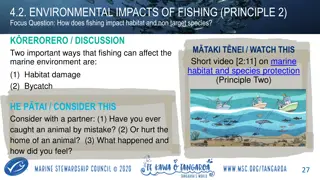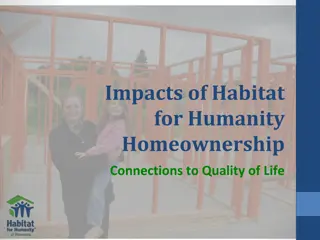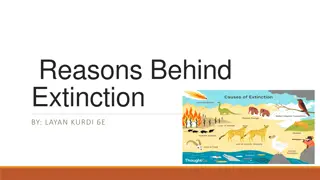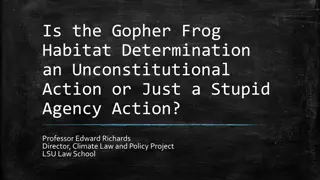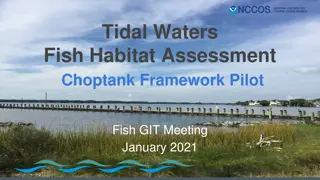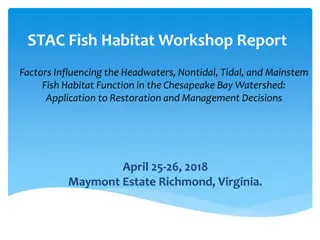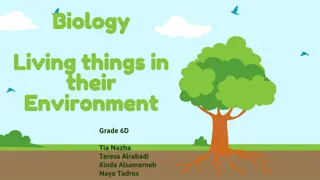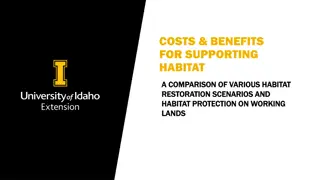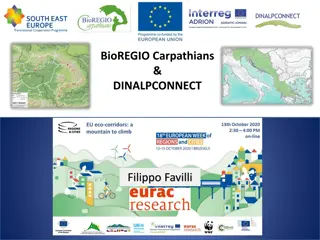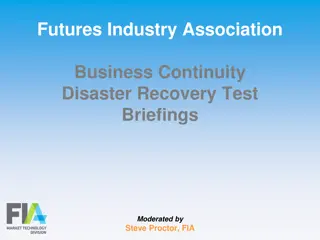Understanding Habitat Connectivity and Landscape Mosaics
Explore the importance of habitat connectivity, landscape mosaics, and metapopulations in preserving biodiversity. Delve into species loss equations, natural mosaics, and human-caused fragmentation, along with solutions. Review concepts related to optimizing land use for biodiversity and economic interests. Calculate the percentage of bird species lost in a wilderness area due to forest burning. Learn about metapopulations and their role in safeguarding against extinction through occasional dispersal.
Download Presentation

Please find below an Image/Link to download the presentation.
The content on the website is provided AS IS for your information and personal use only. It may not be sold, licensed, or shared on other websites without obtaining consent from the author. Download presentation by click this link. If you encounter any issues during the download, it is possible that the publisher has removed the file from their server.
E N D
Presentation Transcript
Habitat connectivity and landscape mosaics Monday 5/15 Species loss equations Meta-populations on networks Natural mosaics Human-caused fragmentation and solutions
Plan for Wednesday Short case study on how to plan land use to optimize both biodiversity and economic interest Review major concepts Go over 2 homeworks
Review Succession B-D+I-E = growth S=cAz
The Species Loss Equation SORIG = cAORIGz Therefore, SNOW = cANOWz
The Species Loss Equation % Species remaining = SNOW / SORIG = (ANOW / AORIG ) z Q13-1. calculate What percentage of bird species will be lost in the Eagle Cap Wilderness if 28% of the forest burns, z = 0.263?
The Species Loss Equation % Species remaining = SNOW / SORIG = (ANOW / AORIG ) z Q13-1. What percentage of bird species will be lost in the Eagle Cap Wilderness if 28% of the forest burns, z = 0.263? %remaining = (72% not burned or 0.72)z %remaining = 0.92 (or 92%) %lost = 1 - %remaining = 8% lost
The Species Loss Equation SNOW / SORIG = (ANOW / AORIG ) z Critique?
Metapopulations Spatially isolated populations are linked by occasional dispersal, creating a metapopulation. Metapopulations provide a rescue effect: Repeated colonization helps safeguard against extinction.
Metapopulations Metapopulations often created by habitat fragmentation. If patches become more isolated, colonization rate decreases. If patches become smaller, extinction rate increases. For a metapopulation to persist for a long time, the patch extinction rate < colonization rate.
Metapopulations Different species have different abilities to cross specific habitats. Example: Many forest interior species will not cross 25 m of open habitat (Laurance et al 2002).
What are Metapopulations? Local scale: Individuals interact Metapopulation scale: A set of local populations are linked by dispersal Species geographic range: Encompasses all local populations and metapopulations
What are Metapopulations? Individual movement among patches is the defining feature of a metapopulation. Dispersal is a function of: Distance between patches Quality of Habitat Mortality during dispersal The type of Matrix
Example: Northern Spotted Owl Lande (1988) estimated that the Northern Spotted Owl metapopulation would collapse if logging reduced suitable patches to < 20%.
Example: Butterflies Bog fritillary butterflies cross unsuitable matrix to nearby patches; but do so less when the distance between patches is larger.
Metapopulation Terminology Habitat patch: where a local population exists Local extinction: disappearance of a population from a given patch Re-colonization: re-establishment of a local population by new immigrants Population turnover: how often the population is renewed Population persistence time: how long a population may maintain itself
Factors Affecting Local Extinctions Broad scale threats Broad Scale Threats Global Climate Change Land-use change and fragmentation Altered disturbance regimes Invasive Species Stochastic Causes
Factors Affecting Local Extinctions Local Scale Threats: Broad scale threats Demographic stochasticity: Random changes in population vital rates. Genetic stochasticity: Loss of fitness due to inbreeding in very small local populations Environmental stochasticity: Environmental changes, especially weather, that may result in fluctuations in resources. Stochastic Causes Catastrophe: Extreme stochastic events that affects the entire metapopulation.
Factors Affecting Local Re-colonization Factors influencing re-colonization reflect the interplay between life history traits and the connectivity to habitat. Plants: seed size and viability, dispersal vector, seedbed requirements. Animals: simple distance, resistance of intervening habitats, dispersal behavior, mortality rates during dispersal.
Metapopulations 13-2 Draw a cartoon of metapopulation List a few factors that are threats to metapopulations.
Island Biogeography vs. Metapopulation Island Biogeography Model Metapopulation model Habitat Variables: Island area Habitat Variables: Patch area Distance from source (mainland) Habitat abundance or variety Distance between habitat patches Habitat quality
Island Biogeography vs. Metapopulation Island Biogeography Model Metapopulation model Species Variables include: Species variables include: Ability to traverse distances Demographic parameters for local population dynamics Robustness to genetic bottlenecks Dispersal range and/or mobility, dispersal behavior Habitat affinities, territory or home range size Interactions with other species
Actions to save biodiversity More natural reserves Reserves with buffer areas Many small or several big ones Connectivity
Nature Reserves We should design reserves with configurations that help: maintain the largest possible populations. provide habitat throughout the range of target species. Connect to other reserves to maintain metapopulations.
Nature Reserves with Buffer Zones Augment core areas with buffer zones areas with less stringent controls on land use, but that can still meet the requirements of many species Buffer zones can also be managed for: sustainable harvest of resources agriculture, limited housing.
Biosphere reserves have zones that vary in permissible human impact (564 worldwide)
Designing Nature Reserves Best spatial configurations for a core natural area? There has been great debate over whether Single Large or Several Small reserves is better. (The SLOSS Debate)
In 1979, Thomas Lovejoyset up 1, 10, 100, or 1,000 hectare plots surrounded by logged land: The Dynamics of Forest Fragments Project. More species in 1 hectare of Amazonia than in all of Europe! Found that most forest fragments are too small to maintain all their original species. E.g., 100 hectare plots lost their bird species within 15 yrs (Ferraz et al. 2003) From Cain et al. Ecology.
Designing Nature Reserves Habitat corridors linear patches that connect blocks of habitat. Connectivity can reduce the effects of fragmentation by preventing isolation of populations. Do corridors work?
Maintain Landscape Permeability Matrix is less permeable when it is very different from the core habitat. Few animals will travel far through any matrix habitat unless they can use stepping stones or corridors. Stepping stones are relatively small patches of native vegetation scattered throughout the landscape. E.g., the rufous hummingbird stops in small mountain meadows during long-distance migration (Russell et al. 1994)
Island Biogeography vs. Landscape Mosaic Island biogeographic view Landscape mosaic view Featureless matrix Local populations blink in and out. Recolonization based on movement rates and distance between patches. Complex matrix Matrix affects movement patterns between patterns and recolonization Patch distances are not Euclidean
Metapopulation Solutions Elephant Underpass Connects Cousins in Kenya Jason Straziuso/AP Source: NPR News 1/28/11
Corridor Effectiveness How effective are habitat corridors? Savannah River Ecological Laboratory (Tewksbury et al. 2002) Patches of early successional habitat were established in a matrix of pine forest, some connected by corridors. Controls had same area but didn t lead anywhere.
Corridor Effectiveness Effective for butterfly movement, pollen, bird-dispersed fruits (Tewksbury et al. 2002). Other studies of corridors have found negative effects, or no benefits. Why not always effective?
Plan for Wednesday Short case study on how to plan land use to optimize both biodiversity and economic interest Review major concepts Go over 2 homeworks





